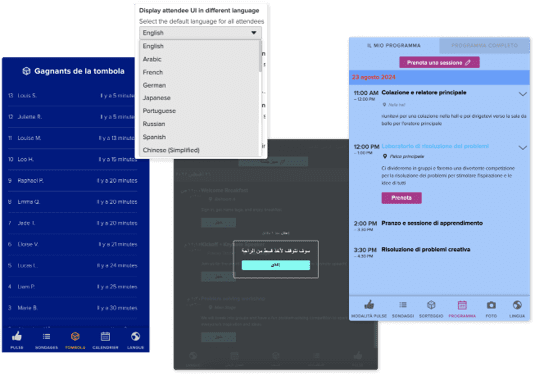In today’s globalized world, the ability to communicate effectively across language barriers is not just a nice-to-have, but a necessity for successful international conferences and events. Language barriers can lead to misinterpretations, missed information, and ultimately, a disengaged audience. Here are some of the critical pain points associated with language barriers in international settings, and how addressing them can transform your event into a more inclusive, engaging, and productive experience.
Understanding the Impact of Language Barriers
Misinterpretations and Missed Information
When attendees do not speak the language in which a conference is conducted, the likelihood of misinterpretations and missed information increases significantly. This can lead to attendees missing out on important details or misinterpreting the messages conveyed, which diminishes the value of the event for those participants.
Sparse or Non-Existent Attendee Responses
Language barriers can result in sparse or non-existent responses from attendees, who may feel unable to contribute meaningfully to discussions or question-and-answer sessions. This lack of interaction can stifle the dynamic exchange of ideas that conferences aim to foster.
Low Comprehension of Instructions or Themes
Attendees who face language barriers often struggle with understanding the overarching themes or specific instructions during an event, which can lead to confusion and a sense of exclusion.
Slow Responses Due to Translation Delays
Even when translation services are provided, the inevitable delay in translation can lead to slower responses from attendees who need to process the information in their native language, potentially slowing down the pace of the event.
Legal and Compliance Issues
In countries like Canada, where there are mandates on language use, failing to provide materials or conduct sessions in the required languages can lead to legal and compliance issues, potentially harming the reputation of the event organizers.
Reduced Interaction and Networking
One of the primary benefits of conferences is the opportunity for networking. Language barriers can significantly reduce interaction among attendees, limiting opportunities for forming professional connections and collaborations.
Economic Impact and Market Expansion
Addressing language barriers not only enhances attendee experience but also contributes to the economic impact of the conference by attracting a more diverse audience. This inclusivity can lead to expanded market reach and increased attendance in future events.

Solutions to Overcome Language Barriers
Hiring Human Interpreters
While costly, hiring skilled human interpreters can significantly enhance the comprehension and engagement of non-native speakers by providing real-time, accurate translations of speeches and discussions.
Pre-event Language Support
Providing materials in multiple languages before the event can help non-native speakers prepare better, enhancing their understanding and engagement during the event.
Interactive Sessions
Designing interactive sessions that use visual aids and simple language can help bridge the communication gap and make content more accessible to attendees with varying language proficiencies.
Utilizing Technology
Advancements in real-time translation technology can serve as a cost-effective solution to language barriers. Devices and apps that provide instant translation can empower attendees to participate fully, regardless of the language of delivery.
7 Tips for Breaking Down Language Barriers with Tech
1. Embrace User-Determined Language Selection:
For business purposes and ease of the organizers, many meetings and events around the globe are conducted solely in English. Consider utilizing a platform like MeetingPulse that offers the ability for each participant to use a selector to decide which language they’d prefer to see the content in. This empowers attendees to choose their preferred language for presentations, polls, Q&A sessions, and all navigation elements. Options include comprehensive translation for a specific language or a language selector with a pre-loaded set of choices.

2. Leverage Technology for Real-Time Translation:
Platforms like MeetingPulse integrate seamlessly with real-time translation tools, allowing attendees to follow along in their native language. This fosters active participation and ensures everyone grasps the key points of the discussion.
3. Encourage Pre-Meeting Communication:
Share meeting materials and presentations well in advance, ideally offering translations for the most common languages spoken by your attendees. This allows participants to familiarize themselves with the content beforehand, facilitating better understanding during the live session.
4. Utilize Visuals and Simple Language:
Incorporate clear visuals like charts, diagrams, and infographics into your presentations. These can bridge language gaps and enhance understanding for attendees with varying language proficiency. Additionally, use concise and straightforward language in your presentations and discussions.
5. Encourage Active Participation:
Facilitate discussions and polls with clear instructions and answer choices translated into multiple languages. This allows all attendees to contribute their ideas and participate actively, regardless of their native tongue.
6. Partner with a Language Specialist (Optional):
For highly specialized meetings or those with a significant number of attendees requiring translation, consider partnering with a language specialist. They can provide real-time interpretation or translate key materials beforehand.
7. Utilize Breakout Rooms with Language-Specific Support:
MeetingPulse allows you to create breakout rooms where attendees with similar language needs can gather and discuss topics in their native tongue. This fosters deeper collaboration and knowledge sharing across language barriers.
Combatting language barriers at your conferences and events can greatly enhance the experience for all participants and provide a very personalized method of interaction between the content and other participants at the event. As we continue to move to a fully global economy, ensure that your meetings and events are providing the right foundation and technology platforms to support business in the way it’s conducted today. “Leave no man – or woman – behind” in terms of language.










